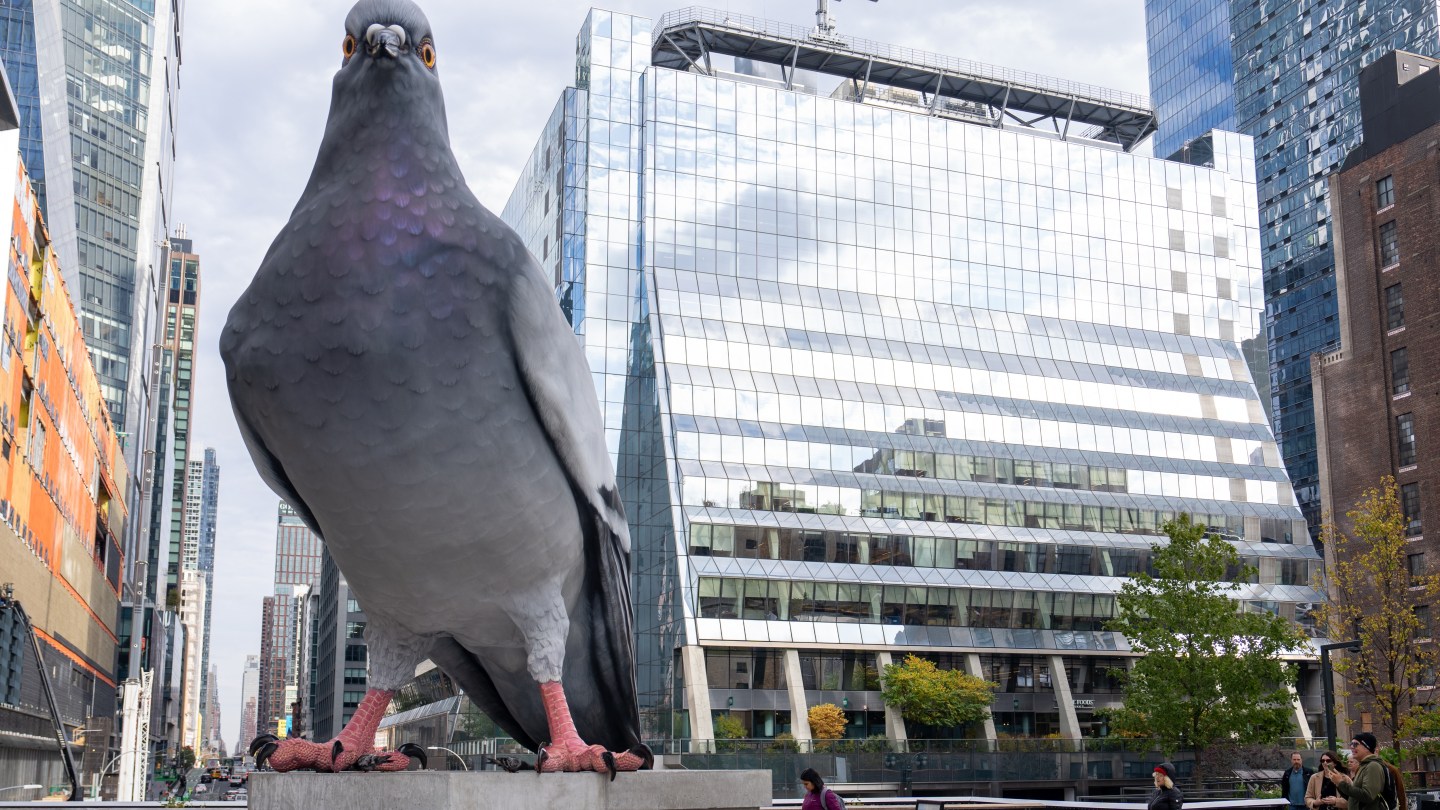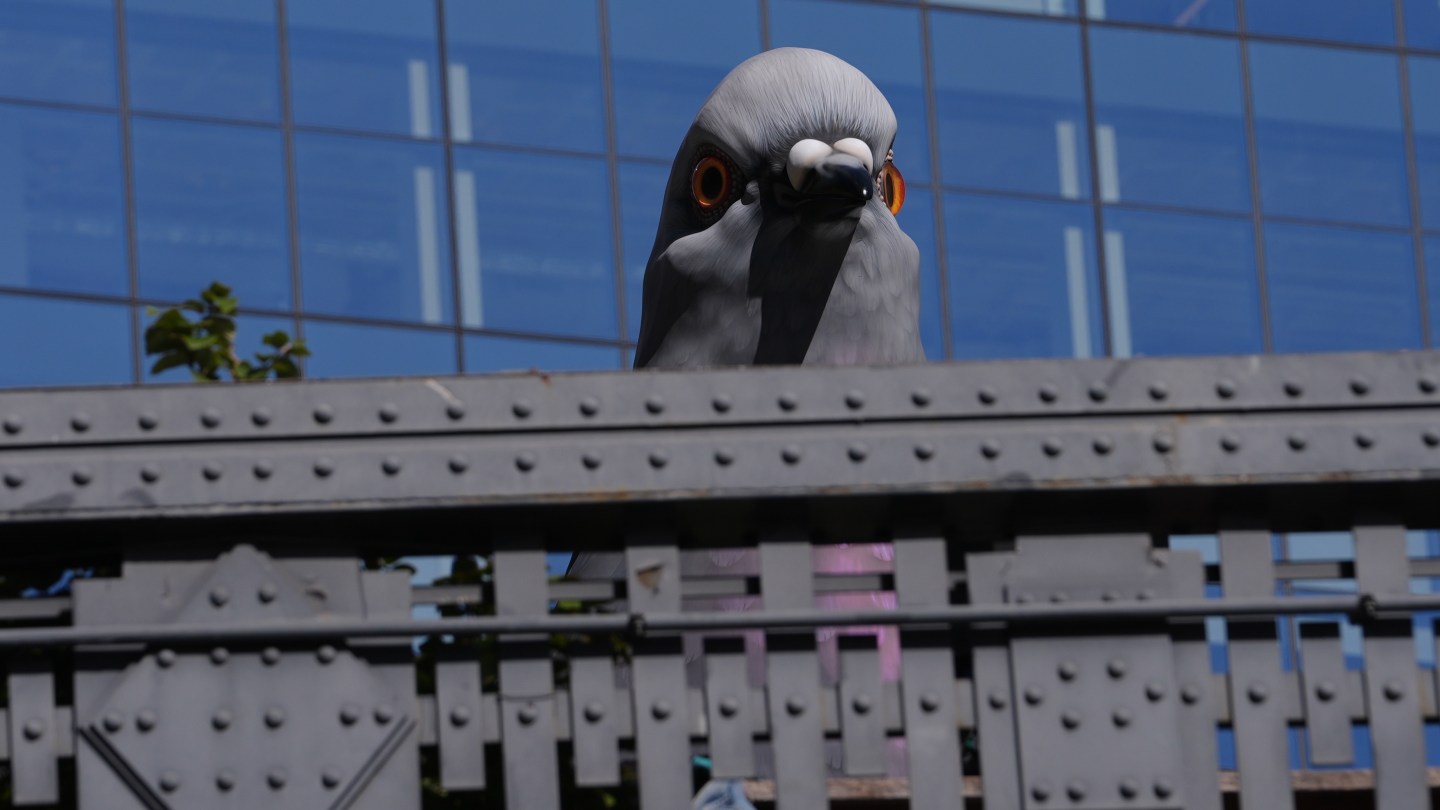The Big Pigeon Isn’t Scary Enough

The first thing I thought when I saw the big pigeon was I wish I didn’t know the big pigeon was here. Oh, I was plenty charmed. It’s a hyperrealistic, 16-foot aluminum pigeon—like pizza, the basic idea is good enough that I’m not really sure there’s any version of the execution that wouldn’t have satisfied me. But I had come specifically to see the pigeon, and achieved that goal, and wished I had been surprised by it instead. Turned a corner and been gobsmacked by the pigeon, or been riding up 10th Avenue and seen the pigeon in the distance, getting ever-closer and -larger. What the hell? would have been my ideal reaction to seeing the big pigeon for the first time. Why is there a pigeon here?
Well, why not? It’s Manhattan. There are pigeons everywhere. Anywhere from half a million to nine million, depending on who you ask. Iván Argote, a Colombian artist living in Paris, has added one more with his sculpture which perches atop the High Line, an unused rail trestle turned linear park, and stares somewhat menacingly down on passing traffic. The sculpture is called Dinosaur (on display through spring 2026), and it does look more than a little saurian at this scale—the claws look like they could properly gut you, perhaps as revenge for all those times you didn’t offer his smaller cousins any crumbs. Close-up foot here, with, helpfully, a pigeon for scale.
Argote has made some big promises about the effect of his big pigeon. “I feel this sculpture could generate an uncanny feeling of attraction, seduction, and fear among the inhabitants of New York,” he said. I did not necessarily feel any of those things as I admired it; it’s too whimsical to inspire any especially intense emotions. But there’s nothing wrong with whimsy. The world can always use some.

The supranormal scale of Dinosaur is its prime selling point. It’s difficult to get one’s head around the dimensions of this thing. From a few blocks away, it doesn’t look so massive, only weirdly detailed, because you have in your head a mental model of how big a pigeon is. Get right up to it, get under it, let it loom over you, and it swells to become the world’s meekest kaiju. Circle it to give it a different backdrop and it appears to change size: against the flat featureless glass of Hudson Yards, it towers; against the monumental granite of a WPA-era Post Office facility, it withers. It’s a work that rewards physical engagement; I would go so far as to say it’s interactive.
Interaction is the point of public art, or at least good public art. This is no stuffy museum. This is out on the street, a place where it’s acceptable to laugh or scream in response to discovery of the big pigeon, and, yes, to spend five minutes getting the perfect Instagram selfie. I had as much fun watching people react to Dinosaur as anything. A daycare group, maybe a dozen small children holding onto their little tether, squealed and chattered and made pigeon cooing sounds at it. Three teen boys clambered onto the plinth see if they could get a view of its cloaca (tastefully obstructed). Tourist after tourist, already drawn by the High Line itself, was visibly delighted to spot the big pigeon, and hurried their pace to get close to it. If a simplistic metric for the effectiveness of art is that it changes something in the viewer, Dinosaur is superficially a success.
Public art is a weird animal. An unalloyed good in purpose, it often falls victim to the crime of having to satisfy too broad an audience, thereby touching no one. Donors and local politicians have to be happy with it, and it has to appeal to so many different tastes, that it can end up bland as oatmeal. Previous works granted the high-visibility capital-P Plinth on the High Line have taken various stabs at making statements but have all felt swallowed up by the space. Dinosaur is the first that seems keen on standing out visually, at the expense of anything deeper. There’s nothing wrong with that, I want to emphasize. But it’s a safe choice.
Especially in New York, where so much of the arts are underwritten by the megawealthy, safe is often the order of the day. Say “public art” and I think of Jeff Koons: factory-produced, self-promotional forced whimsy. Oh, another oversized balloon animal to spruce up the courtyard of the world’s most evil law firm. Great.

But I also think of The Real World, Tom Otterness’s tiny and disconcerting homunculi that cavort in Rockefeller Park, behind my high school, where I and my friends would while away the afternoons. They are whimsical, but they are also dark. Little bronze gremlins obsess over oversized pennies and undersized sacks of cash. A bronze cat stalks a bronze bird. Another cat is bound and gagged and being carried off to who knows were. There are Otternesses all over the city, and they’re always delightful to stumble across; the ones in the 14th St. subway station make waiting for trains there slightly less painful.
I also think of Greg Wyatt’s Peace Fountain, on the grounds of a cathedral right by my childhood home. The biblical imagery gave me occasional nightmares—there’s a big crab and a weird-ass moon and Satan and also hey what’s that guy doing with that giraffe?—but its refusal to ever let a viewer get comfortable with it gives it an attraction that persists even now, some 35 years after I first saw and was unsettled by it. That kind of staying power is rare.
Public art at its best rips an unsuspecting viewer out of the quotidian and forces them to contemplate the aesthetics of something, and their own reaction, in a way that lingers long after the work is out of sight. Dinosaur, at least, succeeds at the first part. “Pigeon, but big”—the common, but off—is an arresting concept. (If I’m to be totally honest, I wish it were even bigger.) But once you get past the concept, there’s just not all that much to return to. It’s a borderline attraction, a civic good that can’t decide if it’s meant to be enjoyed actively or passively, and leaves you feeling pleasant but wanting a little more from either—much like the High Line itself. I wish I had been able to have the initial jumpscare. It would’ve stuck with me longer.







